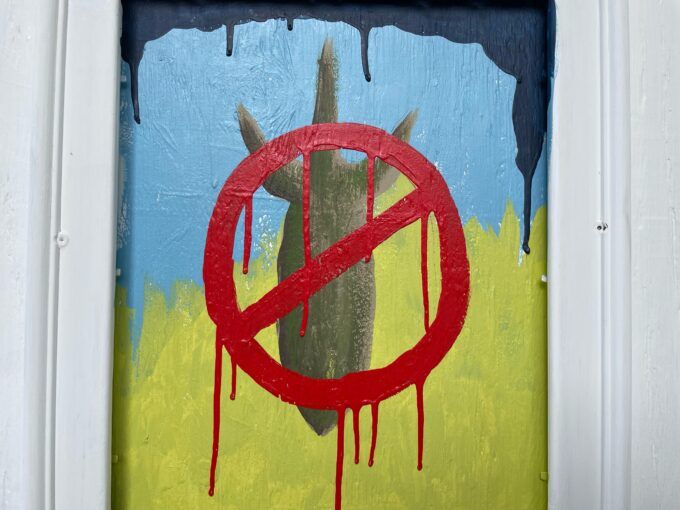
Photograph by Nathaniel St. Clair
Gideon Rachman reported October 31 in a Financial Times column that, “… senior U.S. officials point out that the smallest tactical nuclear weapons might kill hundreds of people, rather than thousands — and devastate and irradiate just a few square miles.”
Rachman’s use of the phrases “might kill hundreds” and “just a few square miles” is outrageous in its callous trivialization of what would occur in the kill zone.
The crude, “small” atomic bomb the United States used to smash and burn Hiroshima was a 15-kiloton device. This “small” atom bomb incinerated five square miles and “…turned into powder and ash the flesh and bones of 140,000 men, women and children,” as historian Howard Zinn noted in his essay The Bomb. Likewise, in Hiroshima in America: Fifty Years of Denial, Robert Lifton and Greg Mitchell reported that the bomb’s detonation resulted in “killing 100,000 people immediately, and fatally injuring at least 50,000 others.”
Today, the “smallest” U.S. nuclear weapons are B61gravity bombs which have a maximum explosive force of between 50 and 170 kilotons, and so are between three and eleven times more devastating than the U.S. Hiroshima bombing. There are 2.9 million people in Kyiv, so one 170-kiloton U.S. B61 could potentially kill 1.5 million of them, and burn 40 square miles with firestorm.
The creation of firestorm or mass fire — simultaneous combustion of many fires over a large area, causing a great volume of air to heat, rise and suck in large amounts of fresh air at hurricane speeds from the periphery — is the unique contribution that nuclear weapons make to humankind’s mechanized destruction. At Hiroshima, “The fire covered an area of roughly 4.4 square miles and burned with great intensity for more than six hours,” according Dr. Lynn Eden in Whole World on Fire, her 2004 study of how and why the U.S. government vastly underestimates the destructiveness of nuclear weapons by failing to consider damage from firestorms.
Rachman and the unnamed “senior officials” vastly understate the physically, medically, socially and ethically grotesque explosive and incendiary force of so-called “tactical” hydrogen bombs. They either misunderstand or have lied, and they cynically imply that the uncontrollable, indiscriminate mass destruction of civilian populations using fire and radiation is a military “tactic.”
Richard Rhodes in The Making of the Atomic Bomb reports, “People exposed within half a mile of the Little Boy [Hiroshima] fireball were seared to bundles of smoking black char in a fraction of a second as their internal organs boiled away…. The small black bundles now stuck to the streets and bridges and sidewalks of Hiroshima numbered in the thousands.” In The Bomb, Zinn notes that of 1,780 nurses in Hiroshima, 1,654 were killed or so badly injured that they could not work.
CNN reported on September 26 that nuclear weapons called “tactical” have “explosive yields of 10 to 100 kilotons of dynamite, [and] are also called ‘low yield.’” But Pentagon boss General Jim Mattis told the House Armed Services Committee in 2018, “I don’t think there’s any such thing as a ‘tactical nuclear weapon.’ Any nuclear weapon used anytime is a strategic game-changer.”
Reuters reported on October 17, “These 12-ft B61 nuclear bombs, with different yields of 0.3 to 170 kilotons, are deployed at six air bases across Italy, Germany, Turkey, Belgium and the Netherlands.” These “forward deployed” U.S. H-bombs are so provocative and destabilizing that hundreds of European and U.S. dissidents, including Members of the European Parliament and this reporter, have committed acts of civil resistance against air bases hosting them.
Whether conscious or subconscious, the chronic dread of impending catastrophe caused by the manufactured and ceaseless threat to “go nuclear” — known as deterrence — was described in all its homicidal absurdity by the coldblooded Winston Churchill in 1955. He said about our governments’ nonstop readiness to commit massacres with nuclear weapons: “Safety will be the sturdy child of terror, and survival the twin brother of annihilation.”
By trivializing the effects of today’s nuclear weapons, Rachman, his unnamed senior officials, and his editors at FT, demonstrate that, unlike Churchill, they either lie about what they know or know nothing at all about the established facts of thermonuclear explosions. Such misinformed or intentional minimization weakens the near-universal stigma of criminality that adheres to the Bomb, and increases the possibility that Hiroshima could be repeated. Such horrifying nuclear “small” talk sanitizes and routinizes military schemes for deliberate mass murder, as if such a thing could be tactical.